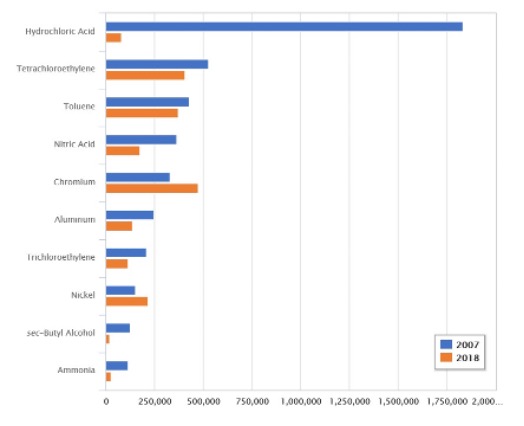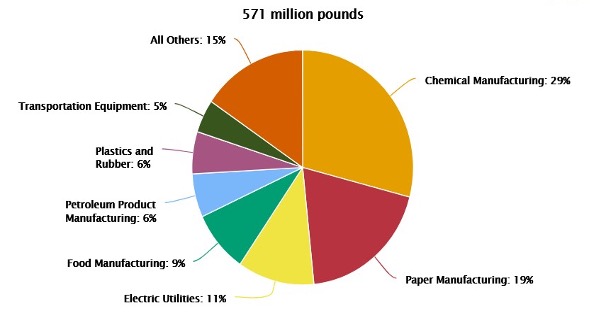- While various facilities use thousands of chemicals, some gases recur in workplaces across industries.
- The typical gases are carbon monoxide, carbon dioxide, ammonia, oxygen, hydrogen sulfide, chlorine, nitrogen, methane, sulfur dioxide, and chloride oxide.
- These gases can be flammable and/or toxic to people. The combustible gases in an oxygen-rich atmosphere can be explosive, causing risks to lives, facilities, neighborhoods, and the environment.
- Using relevant gas detectors with the required precision and concentration range can prevent or reduce damage and harm from these gases.
Industries use several gaseous chemicals or produce them as byproducts. Personnel working in these industries can be exposed to these gases in handling, storage, transportation, workplace, and confined areas. Several industrial gases can be flammable, toxic, asphyxiants, or environmental polluters and should be maintained below legally prescribed levels set by national governments or international organizations. Find out the common gases encountered in ten major industries that must be monitored and controlled to protect personnel health and lives and facility safety.
-
Aerospace Industry

Image 1: “T.R.I. releases by aerospace manufacturing facilities, 2007 and 2018”. (Image credits E.P.A.)
The aerospace industry manufactures aircraft, missiles, and spacecraft. Several toxic gases are produced and generated as waste during production and use, see Figure 1.
The gases used and released as waste from manufacturing units are chromium, ammonia, and sec-butyl alcohol vapors.
Air and space grafts use toxic propellants like hydrazine, dinitrogen tetroxide, toluene, xylene, and methyl ketone. Carbon monoxide formed through incomplete combustion of carbon-based fuels can harm occupants. Oxygen levels are also monitored for enrichment that can cause combustion and for a deficiency that can affect people.
The industry has reduced its releases into the environment chiefly through good operating practices, process, raw material, and product modifications, spill and leak prevention, cleaning and degreasing, and surface preparations and finishing.
-
Agriculture and Fertilizer Manufacturing
Fertilizers are manufactured to supply nitrogen, phosphorus, and potassium to crops. The primary air pollutants from manufacturing the three fertilizers are sulfur oxides (SOx), nitrogen dioxide, nitrous oxide, hydrogen fluoride, ammonia, soot, and dust.
Farmers can also track some gases released in the field since crops do not use all the fertilizers added. Only 35 to 50% of the chemical fertilizers added are used, and the rest seep into the soil and groundwater or are released into the air. Only 50% of nitrogenous fertilizers are used by plants, 15–25% reacts with soil compounds, 2–10% leaches into water systems, and 2–20% vaporizes into the air. The vaporizing part contains nitrous oxide (a greenhouse gas), ammonia, and nitrogen.
Manure and slurry from animal husbandry are significant sources of methane, a potent greenhouse gas.
-
Chemical Manufacturing Industries
The chemical manufacturing industry is diverse and produces several essential chemical products, such as gases, petrochemicals, dyes, pigments, synthetic materials, paints, films, inks, explosives, and cleaning agents. Even pharmaceutical manufacturing can be included under chemical production. According to the US EPA, chemical producers are the number one contributors to air pollutant releases, see Figure 2.
Several raw materials, byproducts, and waste can be toxic.
The significant pollutants from chemical facilities are arsenic, cadmium, chromium, cyanide, lead, and mercury. The list of toxic gases that are occupational hazards for chemical plant workers is long. It includes ammonia, carbon monoxide, chlorine, hydrogen, hydrogen chloride, hydrogen sulfide, nitric oxide, nitrogen dioxide, and sulfur dioxide. Volatile organic compounds (V.O.C.), which are used as raw materials, vaporize quickly and are another major group of toxic pollutants in chemical facilities and include compounds like formaldehyde, benzene, toluene, and chloroform.

Figure 2: “Air releases by industries in 2022” (Image credits E.P.A.)
-
Healthcare Industry
The staff in healthcare facilities encounter several chemicals, which can either be specific to a workstation or due to general use.=
Specific Use
Staff at specific workstations using chemicals in large quantities as part of their daily work can be exposed to higher than recommended levels of gases. These include laboratories, sterilizing, and disinfection facilities.
Gases in specific workstations can be laboratory reagents like alcohol, formalin ethanol, V.O.C.s (toluene and xylene), and methanol. These are gases or produce vapors. Also, several chemicals used as sterilants and disinfectants, including toxic gases, must be strictly monitored. These include ethylene oxide, glutaraldehyde, hydrogen peroxide (vapor and gas plasma), and peracetic acid. Dental practitioners use nitrous oxide and could have high levels of exposure to the gas.
General use
Some toxic chemicals and gases, such as cleaning products, are used everywhere in the hospital. These include general-purpose, glass, bathroom, and tile cleaners, furniture maintenance, dusting aids, waxes, etc. These products can contain paints, dyes, and V.O.C.s that can cause indoor pollution, affecting the personnel using them and everyone using the rooms.
-
Mining Industry
Miners will encounter toxic and combustible gases because of chemicals used in mines or generated during the process.

Figure 3: The different toxic and explosive chemicals in mining, da Silva-Rêgo et al. 2022. (Image credits: https://doi.org/10.1016/j.engeos.2022.03.003)
Methane is the main combustible gas found everywhere in mines, accumulating near roofs and abandoned areas. The other two combustible gases are hydrogen sulfide, found at active work sites and pipelines, and hydrogen. Carbon monoxide formed after fires can also cause explosions.
After fires or explosions, the gases found in mines are carbon monoxide, hydrogen, hydrogen sulfide, methane, nitrogen, and other hydrocarbons. Silica dust is produced during mining.
Carbon dioxide and nitrogen are the inert gases in mines that can reduce oxygen levels, which can be dangerous for miners. Carbon monoxide and hydrogen sulfide are also toxic and life-threatening.
-
Oil and Gas
Many of the gases associated with the oil and gas industry are toxic and flammable. The gases can be components of petroleum and chemicals used or generated as byproducts.
From the oil and gas: Natural components of oil and gas can be hazardous, such as fumes and vapors from leaks. Petroleum gas fumes have toxins like butane, benzene, methane, and mercury vapor. Exposure to high levels of these gases can kill instantaneously. Hydrogen sulfide is formed during the decay of organic matter. Sulfur is a petroleum component, and sulfur dioxide gas is released during exploration and extraction, but mainly during refining.
Process: Diesel exhaust is high as all machinery and vehicles use this fuel. Fracking uses many hazardous substances like acids, proppants, and biocides. The US EPA reports that 1084 chemicals are used in fracking, and the main components are methanol, ethylene glycol, and propargyl alcohol, which can vaporize and are hazardous to people. Faulty equipment releases carbon monoxide due to incomplete combustion. Oxygen levels must be monitored to prevent deficiency.
-
Paper and Pulp Industry
Gases associated with the paper and pulp industries to be monitored can be toxic, flammable, or inert.
Paper and pulp production processes use several chemicals that can be hazardous, such as ammonia, chlorine, chlorine dioxide, ozone, nitrogen, carbon dioxide, sulfur dioxide, and oxygen.
Some gases produced as byproducts are carbon monoxide from combustion and hydrogen sulfide, which are toxic and flammable.
-
Semiconductor Fabrication Facilities
The semiconductor industry uses many chemicals, solids, liquids, and gases for production. Hazardous gases used are toxic, flammable, or corrosive.
The gases used during production that are harmful are ammonia, argon, hydrogen, ozone, arsine, boron trifluoride, chlorine, ethylene oxide, hydrogen bromide, hydrogen chloride, hydrogen fluoride, diborane, hydrogen peroxide, nitrogen, phosphine, silane, and nitric oxide.
Acids and caustics used like cryogens and cyanides that emit vapors can also be dangerous.
Semiconductor wafer production also generates considerable amounts of V.O.C.s.
-
Textile Industry
Gas emissions from the textile industry are the second biggest global polluters. Hence, workers in the textile industry, users of the products, and the general public are affected.
The hazardous gases used in textile production processes are formaldehyde for durability, chlorine for bleaching, ammonia for dyeing, and hydrogen cyanide for nylon production.
Solvents, synthetic dyes and fibers, and plastic and metal accessories used for textile production can release V.O.C.s, such as formaldehyde, benzene, ethylene glycol, toluene, methylene chloride vapors, 1,3-butadiene, tetrachloroethylene vapor, and xylene.
Dangerous gases produced during the process can be sulfur dioxide.
Several additives that are liquids and solids can also be hazardous for staff and end-users, such as flame retardants, fluoropolymer coatings, phthalates in printing ink, etc.
-
Wastewater Treatment Facilities
The hazardous gases in wastewater treatment facilities can be toxic, flammable, and asphyxiants. The gases are mainly produced by waste or are released by cleaning agents.
The main gases produced by treatment plants from the waste materials are carbon monoxide, carbon dioxide, methane, hydrogen sulfide, ammonia methyl mercaptan, ethyl mercaptan, dimethyl disulfide vapors, and V.O.C.s. Many of these gases produce malodors; some, like hydrogen sulfide and methane, are combustible and explosive, and others are toxic. Methane, hydrogen sulfide, and carbon dioxide buildup can cause oxygen deficiency and asphyxiation.
The chemicals used for harmful decontamination are ammonia, chlorine, ozone, and chlorine dioxide.
Besides these gases, personnel at treatment facilities could be exposed to other gases mixed in the wastewater.
Gas Detectors
Gas analyzers that can detect various industrial gases use several principles. Electrochemical sensors that detect many toxic, inert, and flammable gases are standard devices, that are sought out for their precise and rapid resolution, detection range, and cost. Interscan offers fixed and portable gas sensors for detecting, measuring, and analyzing over 20 gases. These detectors have been used in all ten industries to keep personnel and facilities safe.
Written by:
 Vijayalaxmi Kinhal
Vijayalaxmi Kinhal
Science Writer, CID Bio-Science
Ph.D. Ecology and Environmental Science, B.Sc Agriculture
Sources
CDC. (n.d.). Healthcare Workers- Chemical Hazards Risk Factors. Retrieved from https://www.cdc.gov/niosh/healthcare/risk-factors/chemical-hazards.html
Czarnota, J., Masłoń, A., & Pajura, R. (2023). Wastewater Treatment Plants as a Source of Malodorous Substances Hazardous to Health, Including a Case Study from Poland. International journal of environmental research and public health, 20(7), 5379. https://doi.org/10.3390/ijerph20075379
da Silva-Rêgo, L. L., de Almeida, L. A., & Gasparotto, J. (2022). Toxicological effects of mining hazard elements. Energy Geoscience, 3(3), 255-262. https://doi.org/10.1016/j.engeos.2022.03.003
Department of Environmental Protection. (n.d.). Questions and Answers on Mine Rescue and Recovery Operations Following Coal Mine Fires and Explosions. Retrieved from https://www.dep.pa.gov/Business/Land/Mining/BureauofMineSafety/Services/Emergency/QA/Pages/default.aspx
EPA. (2023, No 1). Aerospace Manufacturing Sector – Pollution Prevention (P2) Opportunities. Retrieved from https://www.epa.gov/toxics-release-inventory-tri-program/aerospace-manufacturing-sector-pollution-prevention-p2
EPA. (2024, March). Air Releases by Chemical & Industry. Retrieved from https://www.epa.gov/trinationalanalysis/air-releases-chemical-industry
Fibre2Fashion. (2013). Textile industry releasing toxins into atmosphere. Retrieved from https://www.fibre2fashion.com/industry-article/6828/textile-industry-releasing-toxins-into-atmosphere
Healthcare Environment Resource Center. (n.d.). Common Hazardous Materials in Healthcare Facilities. Retrieved from https://www.hercenter.org/hazmat/hazcommon.php
International Labour Organisation. (n.d.). Chemical hazards in the mining sector:
An industry case study. Retrieved from https://www.ilo.org/sites/default/files/wcmsp5/groups/public/@ed_protect/@protrav/@safework/documents/instructionalmaterial/wcms_871779.pdf
ISHN. (2019, May 7). The top 5 deadly gases in the oil and gas industry. Retrieved from https://www.ishn.com/articles/110735-the-top-5-deadly-gases-in-the-oil-and-gas-industry
Lawrencia, D., Wong, S.K., Low, D.Y.S., et al. (2021). Controlled Release Fertilizers: A Review on Coating Materials and Mechanism of Release. Plants,10, 238. https://doi.org/10.3390/plants10020238
NRDC. (2019, April 19). Fracking 101. Retrieved from https://www.nrdc.org/stories/fracking-101#what-is
OSHA. (n.d.). Oil and Gas Extraction- Health Hazards Associated with Oil and Gas Extraction Activities. Retrieved from https://www.osha.gov/oil-and-gas-extraction/health-hazards
Overseas Environmental Cooperation Center. (n.d.). Fertilizer Manufacturing Industry. Retrieved from https://www.env.go.jp/earth/coop/coop/materials/air_poll/e_04.pdf
Wilson, J. (2022, Nov 4). Toxic Textiles: The Chemicals in Our Clothing. Retrieved from https://www.earthday.org/toxic-textiles-the-chemicals-in-our-clothing/


